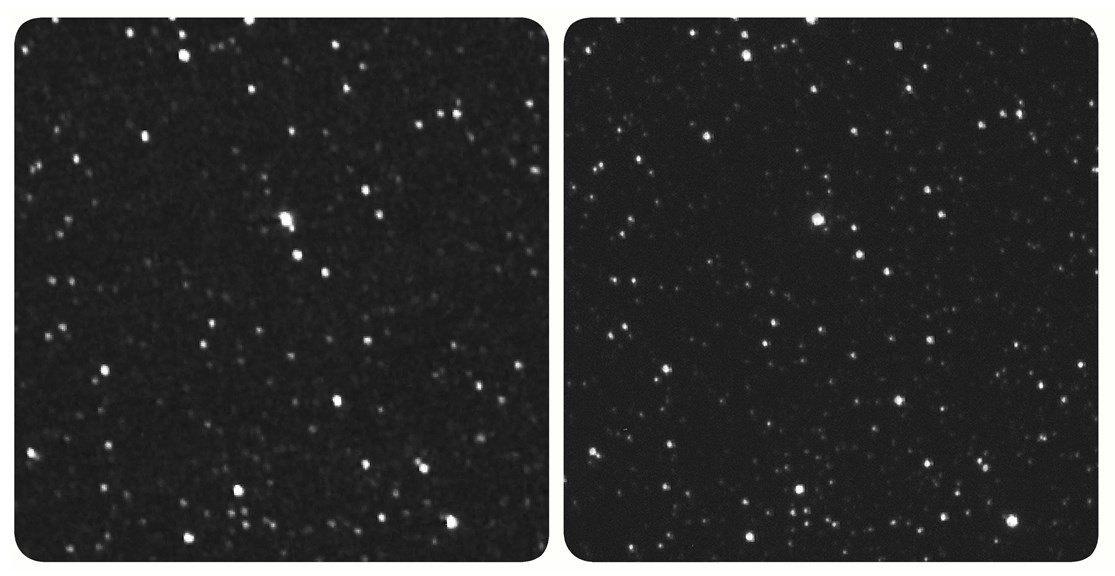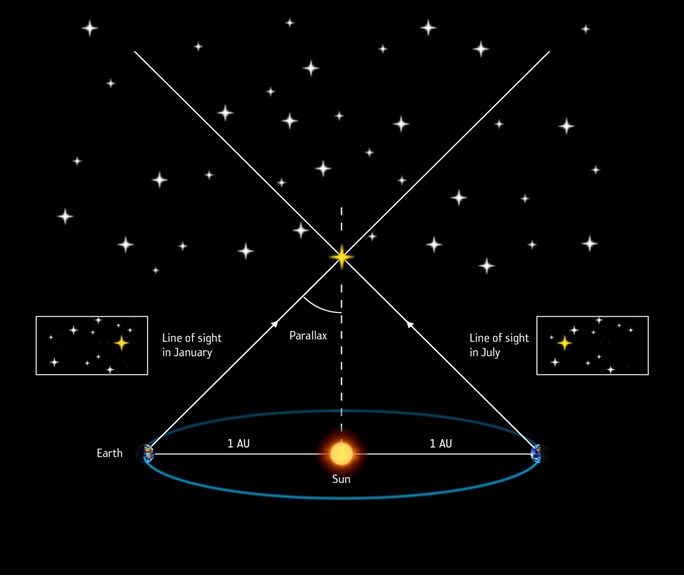Skynotes: July 2020
An Interstellar Spot-the-Difference
Can you spot the difference? It’s a change of position of our sun’s nearest neighbour, Proxima Centauri, in two images, one taken from the spacecraft New Horizons (left) and from Earth (right).
In April the spacecraft transmitted back pictures from deep space enabling the first ever interstellar parallax experiment to be carried out. Using its long-range camera it imaged a starfield that included Proxima Centauri (at 4.2 light years) which was then compared to an image from Earth of the same region on the same date. The result is an apparent ‘shift’ against the distant background stars caused by the two widely separated viewing angles, one from the spacecraft and one from Earth. This superb demonstration of the principle of parallax took advantage of a very wide baseline, namely the distance from Earth to New Horizons of 7 billion km.
Knowing the baseline or distance between observations, and the angles involved, it is a simple matter to work out far away the star is. The further apart the observations are, the larger the shift seen, and the more accurate the distance. By using the diameter of Earth’s orbit telescopes here work out distances to objects out to several hundred light years, but observations made billions of kilometres apart could reveal distances to stars, clusters and nebulae much further out in the galaxy.
This interstellar experiment also included an image of another object, the nearby star Wolf 359 (at 7.9 light years), which was similarly compared against an Earth-based image of that star. The timed observations of Proxima Centauri and Wolf 359 used telescopes at Siding Spring Observatory, NSW and in Arizona, USA.
New Horizons, launched in 2006 and with fly-buys of Pluto in 2015 and Arrokoth in 2019, is the spacecraft that just keeps on giving, with an extended mission taking it on a journey further out through the Kuiper Belt.
Find out more on the NASA website and SPACE.com.
Planetarium
Melbourne Planetarium and Scienceworks have reopened! Tickets are on sale now and must be booked online ahead of your visit (including Members).
Melbourne sun times
| Date | Rise / Solar noon* / Set (day length) |
|---|---|
| Wednesday 1st | 7.36am / 12.24pm / 5.11pm (9.35 hrs) |
| Saturday 11th | 7.34am / 12.25pm / 5.17pm (9.42 hrs) |
| Tuesday 21st | 7.29am / 12.26pm / 5.24pm (9.55 hrs) |
| Friday 31st | 7.21am / 12.26pm / 5.32pm (10.10 hrs) |
*When the Sun is at its highest crossing the meridian or local longitude.
Moon phases
| Phase | Date |
|---|---|
| Full Moon | Sunday 5th |
| Third Quarter | Monday 13th |
| New Moon | Tuesday 21st |
| First Quarter | Monday 27th |
This month’s Moon apogee (furthest from Earth) is on Monday 13th at 404,199 km and perigee (closest to Earth) is on Saturday 25th at 368,361 km.
Planets
Mercury is not visible this month as it is entirely a daytime object.
Venus rises around 4:30am and fades in eastern daylight by 7am.
Earth, which has an elliptical orbit around the Sun, reaches aphelion (furthest from the Sun) on Saturday 4th at 152.1million km. This is 5 million km more than perihelion (closest to Sun) which was on 3rd January. The Greek prefix ‘apo’ means far, ‘peri’ means near or close, and ‘helios’ refers to the Sun. Our planet’s orbit is gravitationally influenced by the Sun and the other planets, but most of all by the nearby moon. It shifts from almost circular to elliptical over 100,000 years and the dates for closest and furthest distance from the Sun vary each year by as much as two days.
Mars rises around midnight and will be lost in the north east by dawn.
Jupiter is easily visible all night across the northern sky. At mid-month it rises at 6pm and sets at 7am.
Saturn follows Jupiter in the north, rising mid-July at 6:30pm and setting in the pre-dawn light.
Meteors
July has no strong showers but in the latter half of July there are some minor showers. Watch around Aquarius and Capricornus and best time is after midnight. July’s main meteor shower is Southern Delta Aquarids peaking on the 28th.
Stars and constellations
The Southern Cross (Crux) is high in the south while the bright stars Canopus and Achernar are found low to the southern horizon.
Scorpius is high in the south east with its curving tail just above ‘the teapot’ or bow and arrow of the centaur archer Sagittarius.
Low in the west is the brightest star visible at night, Sirius, and its associated constellation Canis Major (Greater Dog).
In the north is the inverted question mark of Leo the Lion.
In some Aboriginal traditions the Southern Cross is Bunya the possum sitting high in a tree only coming out at night and always on the lookout for danger, and the brightest star is Warepil or Bunjil the wedge-tailed eagle, chief of the law givers and an important figure right across Victoria.
Explore First Peoples’ astronomy, night sky stories, current research, people, and publications on the Australian Indigenous Astronomy website.
International Space Station
ISS orbits every 90 minutes at an average distance of 400 km appearing like a bright star moving slowly across the night sky. Here are some of the brightest passes expected this month over Melbourne and Central Victoria:
Evening
- Wednesday 8th: 6.32pm–6.36pm, South-West to East
- Saturday 11th: 5.44pm–5.51pm, South-West to North-East
Morning
- Thursday 23rd: 5.42am–5.45am, North to South-East
For predictions go to the Heavens-Above website.
On this day
1st 1770, closest pass to Earth of any known comet: Comet Lexell at 2.2 million km (roughly 5.5 times the moon’s distance).
4th 1054, Chinese and other astronomers witnessed the supernova explosion that produced the Crab Nebula 6500 light years away.
4th 2005, Comet Tempel 1 is crashed landed on by Deep Impact probe (USA) to analyse its composition.
4th 1868, birth of Henrietta Swan Leavitt who established the luminosity-period relationship of Cepheid variable stars allowing Edwin Hubble to show ‘nebulae’ were other galaxies beyond our own.
5th 1687, Isaac Newton’s Mathematical Principles of Natural Philosophy was published laying the groundwork for much of modern science.
7th 1959, Venus’ diameter and atmosphere was determined when it occulted the star Regulus in Leo.
8th 2011, the space shuttle Atlantis (USA) was launched on the final mission for the shuttle program.
10th 1962, first communications satellite, Telsar, was launched.
11th 1979, Skylab 1 (USA) was destroyed during re-entry over Western Australia scattering debris over a wide area.
14th 1965, Mariner 4 (USA) made the first controlled flyby of Mars and returned the first close-up images of the planet.
16th 1746, Giuseppe Piazzi, discoverer of dwarf planet Ceres in the asteroid belt, was born.
16th 1969, Apollo 11 (USA) launches to moon for the first lunar landing 5 days later.
16th 1994, Jupiter is stuck by over twenty fragments of Comet Shoemaker-Levy 9.
20th 1969, Apollo 11 (USA) Moon landing when Lunar Excursion Module ‘Eagle’ touched down in the Sea of Tranquility.
21st 1969, first humans set foot on another world. At 12:39pm AEST Neil Armstrong became the first person to step onto the Moon followed 20 minutes later by Buzz Aldrin, while the third Apollo astronaut, Michael Collins, remained in the Command Service Module ‘Columbia’ in lunar orbit. Armstrong and Aldrin were on the moon for 21hrs 36min.
22nd 1784, first use of parallax and hence calculation of the distance to a star by Friedrich Bessel.
23rd 1995, Alan Hale and Thomas Bopp discover comet now named after them.
23rd 1928, Vera Rubin born – famous for analysing rotation rates of galaxies.
24th 1969, first lunar landing mission, Apollo 11, ends with Command Module splashdown in the Pacific Ocean.
30th 1971, first Lunar Rover used on the moon in Apollo 15 Mission.
29th 2005, dwarf planets, Eris and Makemake, are announced leading to Pluto becoming a dwarf planets as well.








